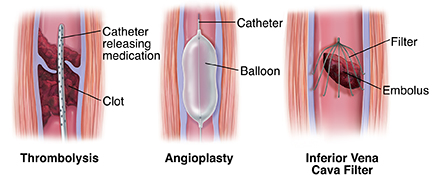Procedures for Deep Vein Thrombosis
A deep vein thrombosis (DVT) is a blood clot in a large vein deep inside a leg, arm, or other part of the body. The clot can separate from the vein and travel to the lungs, making it hard to breathe. This forms a pulmonary embolism (PE). In the lungs, the clot can cut off blood flow. This is a medical emergency and may cause death.
Healthcare providers use the term venous thromboembolism (VTE) to describe the two conditions, DVT and PE. They use the term VTE because these conditions are very closely related. And so are their prevention and treatment.
Most often, a blood clot is treated with medicines that help to dissolve the clot. They also help prevent pulmonary embolism and other complications. But this isn't true for everyone. Depending on your health, and the size and location of the blood clot, your healthcare provider may advise that you have one or more procedures. Procedures to treat blood clots include:
Your healthcare provider can give you more information about treating your blood clot, including information about these and other treatments. They can also answer any questions you may have.

Thrombolysis
This procedure is used to dissolve a large blood clot. A thin tube (catheter) is inserted into the vein. X-rays are taken of the vein and the clot. Then, clot-dissolving medicine is delivered to the clot through the catheter. In some cases, a mechanical device is also used to break up the clot. This procedure isn't advised for everyone with a DVT. Your healthcare provider will review the risks and benefits with you. In some people, thrombolysis is a very effective treatment for blood clots. But it does carry the risk for serious bleeding problems.
Angioplasty
This procedure may be used to widen the affected vein and improve blood flow. This is done after the blood clot has been dissolved. Narrowing (stenosis) of the vein can block blood flow. This makes it more likely for a blood clot to form. A catheter with a balloon on the end is inserted into the affected vein. X-rays are used to position the catheter. Once the catheter is in place, the balloon is inflated to widen your vein. In some cases, a wire mesh device (stent) may also be placed in your vein to help keep it open. You and your healthcare provider can discuss whether or not this procedure might help you.
Inferior vena cava filter
An inferior vena cava (IVC) filter is a small device that's used to trap a blood clot (embolus) in your lower body. This is done to stop the clot from getting to your lungs. A long, narrow tube (catheter) is put into one of your veins. It's used to place the filter in your vena cava, your body’s largest vein. Your healthcare provider will discuss the risks and benefits of this procedure if it's advised for you.